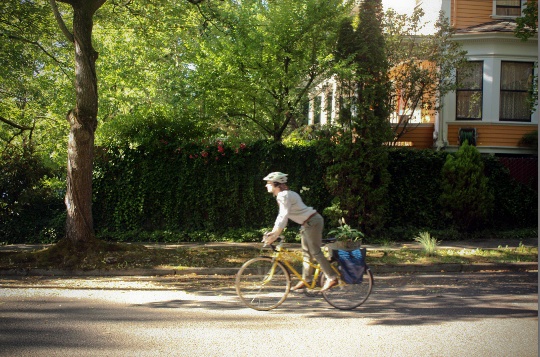
(Photos by L. Mitchell.)
Part of our series of guest posts, America’s Next Bicycle Capital, where we share community voices about the future of biking in Portland.
This week’s guest writer is Talia Jacobson, a transportation planner and ten-year Portland resident.
For those who sort the world by the four types of cyclists (the Myers-Briggs of bike advocacy), most indicators would mark me “enthused and confident.” I’ve been a full-time bike commuter for six years. I take lanes, haul groceries, and ride in just about any weather until ice gets involved. Run down the list of traits, and there’s only one place I break type: skill level.
I could legally vote before I learned how to ride. Years later, there are still days when I’m a slapstick routine on two wheels.
Getting people in the Portland area to travel by bike isn’t just a matter of building better infrastructure (important though that is). To really shift the needle, hundreds of thousands of us will need to make a choice to do something where our lack of skill is embarrassing, even hazardous, and stick with it long enough to get comfortable.
What does it take to make it as an adult novice cyclist? Allow me to share a few lessons from a decade spent trying not to fall down.
Lesson #1: If you don’t learn young, it can take a long time to get around to it. Here’s the short version of why I didn’t learn as a kid: my parents got me roller skates before I’d weaned myself off training wheels. I loved those skates. The bike collected dust till I outgrew it.
So what made me finally learn? In college, I signed up for a semester in Amsterdam, on a program requiring me to be able to ride a bike. Let me just say, there’s a particular combination of gratitude and humiliation you don’t know until you’re 20 and wobbling in circles around an empty parking lot, with your mom and your best friend snickering while they offer pointers. When I left for the Netherlands, one whole month of practice under my belt, I could get a bicycle upright and moving forward. Barely.
Lesson #2: You will fall down. You will mostly be ok. When you first learn to ride, going more than four miles an hour is terrifying. I spent my first weeks in Amsterdam creeping along, staring in dread at the next obstacle in my path, and either hitting it or wiping out in a last-minute effort to avoid it. I wasn’t just incompetent; I was a traffic hazard. Other cyclists and drivers had to swerve around me.
I improved, as anybody does when they spend every day sucking at something and doing it anyway. I got hooked on the thrill of biking around a city. Still, I kept falling. I wrapped my scarf around my cassette, Isadora Duncan style. I snagged my pants cuff on the crank arm and didn’t notice until I was shackled to my bike. Once, I tipped over during an ultra-low-speed turn and a dapper grandfather leapt off the sidewalk to rescue me. My learning curve was made of colorful bruises.
Advertisement
Lesson #3: The basics are more complicated than they seem. I spent years acquiring skills so fundamental that most people don’t think of them as skills. Things like: standing to climb a hill. Coasting down the other side without desperately clutching the brakes. Stepping off the seat and onto the ground when coming to a stop. Making a U-turn. Shifting in any remotely helpful way.
Yes, some people will learn faster, but I know from other novice friends that many don’t. (Shout out to Candy: glad the leg is healing.) I’ve probably picked up one or two tricks a year and still have more to go. If anyone can explain how the hell you a) ride downhill and b) signal in preparation for a turn that doesn’t require a stop while c) also braking, please comment. I’m still convinced this requires three hands.
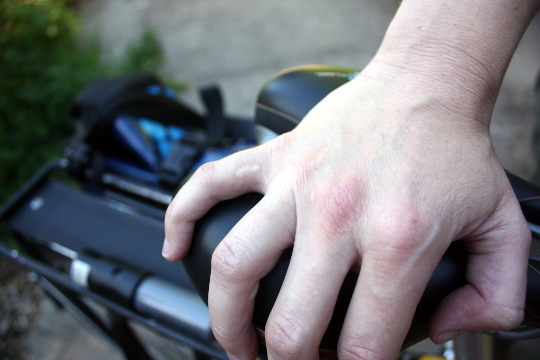
Lesson #4: You will ride bad bikes because you won’t know what you’re missing. The first four bikes I rode were too small, the wrong proportions, and stupidly heavy, but I had no idea because I had no basis for comparison. Only after friends finally convinced me to upgrade to my first decent road bike did I understand how inadequate its predecessors had been.
When you ride bad bikes, it’s hard to tell a mechanical problem from overall slop in the system, so it takes forever to learn the signs that there’s a problem. This kind of thing makes you worse at biking than you actually are. I’ve ridden with everything from a slack chain to a broken axle just thinking my gears were cranky. The most recent time I rode a flat tire across the river? Last week.
Lesson #5: There are everyday ways other people can encourage you, or make you never want to ride again. This site’s full of great information about projects and programs that win over the interested-but-concerned, so I’m going to skip the wonky and focus on the personal. If you want my fellow bike novices to keep riding, here are easy ways to help:
- Teach. Casual instruction is hugely helpful, even in a city full of bike clinics and in the era of YouTube tutorials. Major thanks to all the friends who’ve taught me to patch flats, counterbalance turns, and find good bikes on Craigslist. The element of connection made the lessons stick.
- Ride courteously. Rudeness can be dangerous, and can lead some novices to stick the bike back in the garage indefinitely. I’ve taken falls flinching when another rider cut too close for comfort, and occasionally sent a newbie flailing after I pulled a maneuver that startled them. It doesn’t matter that you’re running late and the person wobbling along on a granny seat is slowing you down. Don’t be That Guy.
- Practice compassion. I owe a lot to the people who had great opportunities to treat me like an incompetent idiot and then didn’t. Friends who went on rides even though I was slower. Mechanics who didn’t roll their eyes when I didn’t know component names. The many, many strangers who’ve stopped to see if I was alright after a fall. You made me feel like it was okay not to be perfect.
Finally, for any newer rider who’s somehow found this post: I’ve been where you are, and I promise, you will get better. With time, you will ride faster, fall less, not get so sweaty, and pull moves that make you feel like a badass instead of like your life just flashed before your eyes.
The best argument for riding a bike? It’s incredibly fun. And the longer you keep at it, the more that will eclipse everything else.
If you’d like to add your voice to this series, get in touch via email: michael@bikeportland.org.


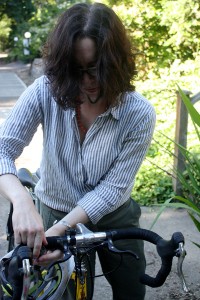
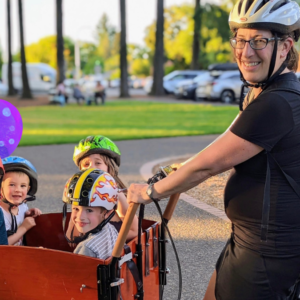


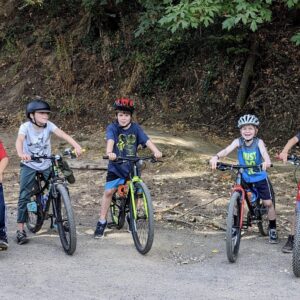
Thanks for reading.
BikePortland has served this community with independent community journalism since 2005. We rely on subscriptions from readers like you to survive. Your financial support is vital in keeping this valuable resource alive and well.
Please subscribe today to strengthen and expand our work.
Get a recumbent trike. Little to no skill involve; just keep your feet on the pedals.
Though there are special hazards… You might sprout a beard or wake up as an engineer.
This engineer resents such generalizations. I wouldn’t ride a recumbent if I was paid to.
Dan, you can turn in your badge, keys, and beard to HR on the way out.
I had a beard and took engineering many years prior to riding a recumbent. Made my first ‘bent myself.
Recumbent is wide. and does not fit in narrow bicycle lane.
I don’t necessarily view falling off or crashing as “falling”, it’s just an unplanned dismount
It’s actually a trick unto itself; the Horizontal Trackstand. Many attempt, few master.
My last one was following the snowstorm. I hit the streetcar tracks, dismounted in “Superman” position, landed on my belly and slid on the ice for 6-8 feet. I then got up, threw my fists in the air and yelled, “Wooooo!”
In San Francisco, the Bicycle Coalition does adult learn-to-ride classes in the car-free part of Golden Gate Park:
https://www.sfbike.org/events/category/learn-to-ride/
What a great post. I was thinking about this just yesterday as I was watching my 10 year old ride along, no hands, super confident. He’s trying to teach me how to ride no-hands, and I’m terrified (and I’m a very competent cyclist!). I can just imagine how he’s going to be different on his bike when he’s my age as opposed to myself :).
And I also have never figure out the downhill/braking/turn signal method either. I’d really like to know how to do it as well.
The easiest way to communicate shifting is watching your chainline.. the closer the chain is to the centerline of the bike, the easier it is to pedal, the lower the gear. As the chain moves outward, it gets harder to pedal, but it allows you to pick up more speed. You however, want to avoid your chain between the front and rear gears to get ‘crooked’. Being too low in front and too high in the back puts undue stress on the chain.. try to keep the line relatively straight between front and rear gears.
Careful riding no-hands—and don’t be embarrassed in the slightest if “you” can’t do it on your bike. It has more to do with bike geometry than rider skill. With some sport bikes, the steering is so “twitchy”, riding no-hands is nearly impossible. With the relaxed head angles of most kids’ bikes, no-hands riding is barely any more difficult that riding with hands on the bars. Most bikes (especially touring bikes) will also behave differently loaded (with cargo) vs. unloaded.
Yeah — I realize that mostly why he can ride no hands are his super thick tires and low center of gravity, as opposed to my thin tires and aggressive geometry. But I’ve SEEN PEOPLE do it on bikes like mine, so I’d love to be able to at least a few times. I just need to get over the fear factor.
Regarding falling — I fell in my driveway a few months ago (clipped in) and messed up the derailer. Took it to bike shop for a quick adjustment and they kept asking me how/where I crashed. I only wish I had crashed — that sounds so much more hard-core than falling in driveway.
If you can get to riding with your fingers just gently resting on the bars, all of your weight on the saddle, then try taking one hand off the bars. Then the other. Keep pedaling – it took me years to learn to ride no hands and not pedaling, the motion of your legs and hips will help you stabilize the bike.
Expect that many times you will immediately lunge forward to grab the bars again. Sometimes I do that too, and I’ve been riding hands-free since middle school.
Practice on very smooth, flat or slightly downhill roads.
Also – one of the things you have to do is strengthen new muscles. You have to support your body differently when you’re riding without hands (all in the hips and torso), and that’s not trivial. As you do that, it will get easier.
It’s not just fear — a twitchy bike is going to be twitchy, and you’ll have to practice (with the light handlebar touch someone else recommended) making it happy with your inputs. But you can usually learn eventually, if you keep at it.
You may also find yourself getting trained to ride one bike no-hands, and not another. I have the weird experience now of not being able to ride a bike no-hands that I could ride no-hands 25 years ago — I got trained to different bikes.
I normally just signal before I brake, then I stop signalling while I brake. There are many situations where you can’t signal while braking and turning, especially when the road is in poor condition, you are wobbling, or slowing down. Especially since the right brake lever controls the REAR brake, which does practically nothing!
You can switch the brake controls. That’s how they set it up in England!
Got to admit I never understood why the American bicycle brake standard is the way it is. Though I’ve always been too lazy to swap the brake levers.
Though what I do, is I keep my rear brake adjusted so it’s not possible to come to full stop when applied, but they rubs enough to greatly slow the bike down, which allows you to slow way down, signal, then use the front to finish the stop or slow down even more if you’re going down hill.
Not sure how I came to doing that, I know others think it’s weird…But it’s how I’ve done it since I was 12.
Yeah – there’s absolutely nothing wrong with having the rear brake on the right & front brake on the left. Motorcycle style. That’s how I have mine.
Do you mean the other way around? Because every bike I’ve ridden has it the way you describe. I don’t know anything about motorcycle handedness.
I was of the understanding that most people are right hand dominate and the hand signals we are taught (via car education) all ultize the left hand for better visibility (drivers are located on the left). Thus we set the bikes brakes up in a way that helps the majority of people from braking hard and flipping over the handle bars and aiding in hand signal stability.
One more skill to add to the list: shifting. I’ve been running into a number of people who don’t understand how to use the gears on their bikes. They’re usually a little bashful about it, but why should they be? It’s not obvious and the bike you learned on probably didn’t have them. I recently gave a little instruction to my mom (a person I feel quite comfortable offering unsolicited advice to) and it’s made her rides a lot easier and more comfortable.
Nice article! I remember first learning to clip in… I was really nervous, and everyone said I would fall at least once. It really wasn’t that hard though, and I began to see why everyone else was using SPDs but me. I bought a pair and started using them confidently, and every time someone said “you’ll fall at least once” I vowed to be that guy that didn’t. I started climbing steep hills and dirt trails, jumping off curbs and over dirt mounds, and having a grand old time. I subsequently switched to road biking, played with different pedal systems, got faster with lighter and lighter frames, even started some racing with my local club.
One evening I was commuting home on Murray and came up to the stop light at TV Highway. It was rush hour and there were also pedestrians and bikers on each corner. I popped my right foot out to set on the curb as I slowly rolled up. I’m sure you’ve felt it before, that slow uneasy feeling as you just start going off-balance to the left when you thought you were leaning right. It takes place in an instant yet feels like an eternity… and then there I was, lying in the bike lane still clipped in on my left, flailing like a turtle on its back trying to untangle my hefty old Gary Fisher off of me. Everyone was looking, some face aghast, some laughing and pointing, a pedestrian ran over to help me up, and fellow cyclists all winced and shuddered with empathy. My knee was banged up but my ego sustained the worst of it.
Then it hit me – well over a decade later – the sound of my long lost friend’s voice echoed inside my head: “you’ll fall at least once – everyone does.”
Heh, thats why I won’t use pedal clips. I found toe cages work well enough!
pedal clips = toe cages
pedals that accept cleats are actually called “clipless”.
Clipless shoes offer a lot. The reinforced foot bed does for cycling what clogs do for people who stand around all day. If you ever get tired feet, master clipless.
Flat pedals aren’t any guarantee against falling. /voice of experience
Other people aren’t paying nearly as much attention to our failings as we think they are.
Easy on yourself–last year a 66 year old retired pro athlete, getting ready to ride at an event organized by his son in B.C., dumped himself on the ground for no good reason while riding to the start. This happened to Eddy Merckx at the grand fondo his son promotes outisde of Vancouver.
And by pro athlete he means the greatest cyclist ever.
Great Post! I feel like I have found a soul sister. I love my bike. I commute and/or ride almost everyday but still hover over the brakes going downhill and need 4 times the space for U-turns as anyone else I ride with. I think there are more of “us” out there than we realize.
This post is the most accurate description of my experience on a bike I have ever read. “Hundreds of thousands of us will need to make a choice to do something where our lack of skill is embarrassing, even hazardous, and stick with it long enough to get comfortable.” For instance, each of these things could have caused me to give up:
* Embarrassing and dangerous: The first time I went to the Springwater and back, I almost threw up when I got home.
* Embarrassing and dangerous: I used to wear a sweatshirt and jeans to ride a bike. It was constricting and hot. As I tried to dress more appropriately, my bike chain chewed up 3-4 pairs of sweatpants that caused me to get stuck while riding. (So now I wear dresses.)
* Embarrasing: I used to practice riding after 10 p.m. so there would be less traffic and less people to see how slowly I went up hills or how frequently I stopped.
* Embarrassing and dangerous: I never got the hang of 10-speed bikes with awkward shifters and a very forward position, but those are the bikes I was given to begin with. I felt totally out of control and uncomfortable.
* Embarrassing and dangerous: I rode an old 3-speed bike for years that I didn’t know how to shift. When I finally figured that out, I was still afraid of multiple chain rings because when I was test riding a new bike I shifted in a way where the chain froze up and ultimately fell off.
* Embarrassing and painful: Nobody ever showed me how to fit a bike other than “how high do you want the seat?” or “does this feel right?” I had no idea what a bike was “supposed” to feel like. When I got my first bike fitting it was a revelation.
* Embarrassing and painful: Learning a bike seat doesn’t have to hurt was a huge relief, because most advice is that “you’ll get used to it.”
* Embarrassing: A mechanic at a bike shop asked if I had a name for my bike and then laughed at me when I did.
* Embarrasing: A guy at a bike meeting laughed at me when I told him I was going bike camping. “On THAT?”
* Embarrassing, dangerous and frustrating: Many, many bike shop repairs and tune-ups have made the bike feel worse than it did when it went in. This causes me more time, money and frustration — and makes me doubt my self-perception. [Still looking for a good bike shop!]
* Embarrassing and dangerous: I am still the slowest cycler I know, so I go on a lot of rides alone so I don’t hold anyone back. Pedalpalooza rides are the exception because they don’t generally go that fast. I still panic when I’m trying to cross the Hawthorne Bridge and I know there are faster cyclists behind me.
…and so on. and so forth. And fortunately, the joy of bicycling still outweighs all that for me. But I totally understand why any of those things would stop other people.
Again, easy on yourself; we’ve all got different skills. I started riding bikes with drop bars and derailleurs in 1966, a green Schwinn 5 speed with a Huret rear derailleur that gave me a forearm like a tennis pro. Learned fast, almost 50 years later I’m still not comfortable on upright bars—but couldn’t learn to drive a car with a clutch until I was 33!
Thanks for sharing your experience. For bike shops, have you tried Velo Cult? As I see it, a shop is defined by its worst mechanic, not its best, and Velo Cult seem to have somehow hired no bozos. With that being said, I don’t get a very beginner-friendly vibe from them. (They’re *friendly* in the general sense and practice great customer service. But you have to know what you want.) Gladys is also excellent and more much inviting.
Try Seven Corner Cycles in the SE. Corey is fantastic, and all of the mechanics there are great. Love them all!
I was never a frequent or confident rider when I was a kid, so when I decided to get myself a bike at just shy of 40, I had to learn how to ride all over again. I felt stupid, I felt embarrassed, I felt like a big baby, and I was scared a lot of falling and pretty much everything else. For me, one of the biggest helps was my husband who continually encouraged me and not once made fun of me (even when I was sure I deserved it!). I live near enough to the i205 path that I could work on basic skills there without having to deal with traffic (though some of the cyclists who blow through there were unimpressed with me). When I got more confident, I joined a couple of Pedalpalooza rides. Riding with a large group of bikes (a separate skill in its own right, I’ve discovered), with spotters at the front and rear and each major intersection, helped me work on riding in the roads.
It also helped that the place I got my bike – Bike Gallery – was really good to me. I was clearly a newbie, no idea what I wanted except that I knew I needed a bike where I could sit fully upright because of nerve issues in my arms. Unlike more than one car salesman I’ve dealt with, the first question out of the bike shop guy’s mouth was *not* “What color did you want?” I’ve been back for products, services, and workshops since, and always felt like they saw me as a valid member of the Greater Biking World. I won’t be breaking any speed records anytime soon, I don’t do 30-mile/45-degree mountain bike climbs, I don’t ride 40 miles to work and back rain or shine, but I do ride sometimes, and that’s good enough for them to treat me like a real customer, and even when I ask dumb questions, they take me seriously because really, there’s no reason not to educate me.
In the handful of years since that first ride at nearly 40, I now ride my bike the 3-5 miles to work sometimes (depends on weather and how much crap I have to cart back and forth), sometimes I ride to the nearest Farmers Market, I’ve done a handful of Pedalpalooza rides, sometimes I ride 4-10 mile sections of the I205 path and the Springwater Corridor just for fun, and twice now, my husband and I have ridden the 12 miles along the Springwater Corridor to OMSI and along the waterfront. On our rides, we’ve seen rabbits, deer, snakes, ducks, an escaped budgie (hanging out with the sparrows), fields and ponds and floodplains not visible from the street, amazing frankenbikes and wonderfully decorated bikes, and little kids who kick my ass on hills.
Realizing how scared I was to do all of this, and doing it anyway, has carried over into the rest of my life. Plus, I’m to the place where, at least most of the time, it’s fun! I’m glad I’ve stuck with it. 🙂
An excellent and encouraging story, WendP! i think it’s important to validate slow progress rather than minimize it.
“If anyone can explain how the hell you a) ride downhill and b) signal in preparation for a turn that doesn’t require a stop while c) also braking, please comment. I’m still convinced this requires three hands.”
Well, since you asked…
Braking with one hand can be tricky—I think the tendency is to pull on the handlebars with your braking hand, which of course upsets the inverted pendulum that is an upright bicycle. To successfully brake with one hand, you must anchor your thumb around either the brake hood or the curved part of your drops, then, if on the hood, think of rolling your hand forward to squeeze the brake lever (like shooting a gun: squeeze, don’t pull). If in the drops, focus on squeezing the crook of your thumb and fingers together, NOT pulling back on the brake lever.
The other force you have to be ready for is what happens when you actually begin to slow down: you will be pushed forward slightly (just like in a car when the driver brakes), which can cause you to push on your handlebars if you’re not expecting it. You must balance the tendency to pull the handlebars when you brake with the tendency to push the handlebars as you slow.
Of course, you have an advantage with your interrupter levers (‘cross brakes); since they sit closer to the center of your bars, the forces of unintentionally pulling or pushing on the bars will be less. If I had to signal while braking (which I do many times each day), I’d likely prefer those interrupter levers over the “main” brake levers. Apply the same squeezing technique—bring the thumb and fingers together rather than just pulling with your fingers—but I would bet using your central levers will make it easier to learn the feel of one-handed braking.
I’d start by practicing the wrist-rolling or squeezing motion while just standing over my bike (not moving). Then while moving, I’d practice with my non-braking hand hovering over (or even lightly touching) the other side of the handlebars ready to grab and steady if needed.
As an addendum/confession—I had to understand and deal with similar forces when I got my first bike with “brifters”. At first, pushing sideways on the brake lever to shift always made me swerve and wobble, but then I discovered I could use my thumb to help balance things out, just like with braking. If you play guitar, some of the left-hand techniques are somewhat transferable to operating bike brakes and “brifters”.
I’ve had in the back of my mind an idea to pen an updated ‘standard’ method for hand signaling while on a bicycle, and then try to get LAB to adopt it. It could then serve as a newer guideline for state DMVs to incorporate into their driver and bicyclist manuals.
In current text, hand signals are still based on what drivers used in horseless carriages before blinkers were invented (and subsequently ignored ;). They use the left hand because the driver is on the left of the car, whereas a cyclist is often busy braking with the left hand (front brake) when executing a turn or stop. My ‘standard’ would illustrate signals we already know but notably with either left or right arms, as well as incorporate the ‘taking the lane’ protocol (45-degree point) often used by both bike and motorcycle riders.
My other idea is to convince SRAM and/or Shimano to incorporate a signal for when the front brake lever is actuated on their electronic systems (it could even be an ANT or ANT+ packet), which could then be used in a rear brake / tail light cluster, but that’s another story…
It’s also legal just to point where you’re turning. See http://www.oregon.gov/ODOT/HWY/BIKEPED/docs/bike_manual.pdf p.8.
Remember that you have many more avenues of expression on a bike than in a car. I have some tricky 5- and 6-way intersections where I point at the place I’ll be directing my bike instead of using a Standard Issue hand signal. And I often simply tell other riders what my intentions are (“changing lanes ahead,” “I’ll pass on your left then turn right in front of you,” etc.)
…am so glad I don’t have drop bars. You made my day!
Still have the same problems with one-hand braking, just not as many different ways you have to learn to overcome it.
I was going to suggest that the author take off those suicide brakes and raise her bars up so she’s comfortable staying on the hoods or the drops. If you’re already not all that confident with your bike handling, the worst thing you can do is hold on to the top of the bars all the time – you’ve got the least amount of control possible in that position.
The newer “interrupter” levers are not the same as the “suicide brakes” of old. The newer style levers actually grab the same brake cable as the regular brakes and pull it just as hard. Old “suicide brake” levers were crappy secondary levers that just pushed on the primary levers.
“…least amount of control possible…”
That’s why it’s good for practicing something where you might exert unwanted “control”.
When I say “least amount of control”, I mean that it makes it hardest to keep the handlebar oriented in the direction you want while doing something else at the same time, like braking one-handed. There’s a good reason why bikes with drop bars are rarely sold with interrupter levers – they tend to encourage riders who aren’t used to drop bars to stay on the tops all the time, and that’s really not a safe way to ride.
Honestly, the bad habit of riding on the tops seems endemic in Portland specifically, and I’m not sure why; maybe people are setting their bar height based on fashion instead of fit? I’ve done informal surveys while riding on the Springwater Corridor and it seems like, of the people with drop bars, probably 80% are on the tops when we cross paths. It’s just weird, I did the same count on the Midtown Greenway in Minneapolis and I saw almost nobody ride on the tops, they either used their hoods/drops or they just rode a flat bar. If you’re in an uncomfortable position when your hands are on the hoods it’s a better solution to raise your stem.
I know what you’re saying about holding on close to the center of the bars, but I don’t know why riding on the tops would be considered a “bad habit”. I have drop bars, but I don’t use the drops very much; do I have a “bad habit” of riding on the hoods? As a shop mechanic told me once, “hand positions is hand positions”. I use the bar tops all the time for climbing, and if I had interrupter levers, I’d use them when I needed to keep the ability to brake while temporarily sitting up for a better view of an intersection, which is likely where I’d be if I found myself having to slow and signal a turn at the same time.
There is also a big difference between riding with one hand and riding with both. I agree that having both hands farther out (on hoods or drops) gives more fine control and better leverage, but I consistently find that if I want to grab my water bottle, holding the bar top close to the center gives a much more stable ride while operating one-handed—especially if there are even small bumps in the road.
Maybe I should clarify that for certain maneuvers or in particular situations, riding on the tops gives certain advantages, but it’s not necessarily useful all the time.
Or just ditch the drops, if you aren’t racing or biking for sport there really isn’t a need for the aero crouch of drops.
An upright riding position is much better for urban riding. You’re more easily seen, you see more, looking behind you isn’t as difficult, less stress on your abdomen, arms and hands (ie you’re more comfortable so you can ride for longer distances), less twitchy steering.
Besides you can still crouch down for head winds, just place you hands more center of the bar, elbows out, and lean way down. Works well with a little practice, just don’t swap you hands to opposite side of the stem—not a fun lesson to learn.
“if you aren’t racing or biking for sport there really isn’t a need for the aero crouch of drops.”
Yes!
I didn’t think anyone still used those.
Don’t stick your elbows out; rotate your hands back (like revving a motorcycle) and drop your elbows down above/beside your knees. Otherwise you’re not reducing your frontal profile as much as you think you are (unless you’re 7′ tall). A Bicycling article I read long ago advocated getting skinny first, then getting low. My experience says it works; when I descend on my old flat-bar bike, elbows down and in makes a difference over elbows up and out.
I like my drops for enhancing some of the descents on my commute, or for fighting headwinds. Plus, I don’t know whether I could put all my weight on my saddle for an hour at a time.
Blessed are the poor in spirit, for theirs is the kingdom of heaven. Blessed are the humble, for they shall ride on smooth, glass-free asphalt with the wind at their back, and traffic will part in front of them like Moses at the Red Sea.
I can stand on my pedals, but it seems like a lot of effort for not that much of an increase in power. My bike just seems unimpressed with me when I try. I see a lot of doing it people on flat pavement , too. Is it because my bike is a mountain bike or something?
Suspension sucks up most power increases from standing. If your mountain bike has suspension, then yes you likely won’t notice a huge difference.
As much as I admire the writer for her preserverance- as a non- rider, this article did not inspire much confidence. Why? I hate getting hurt. I hate being scared or intimidated by traffic or other more experienced riders. And, I hate humiliation. Finally, I have 2 young kids and can’t afford to break an arm or bang myself up. I wouldn’t mind joining the biking community, but everyone is so SERIOUS about it here. I wish biking was more relaxing and less technical as well as political. For now, I’ll stick to my car and frequent runs to stay in shape.
One of my favorite things about cycling is the opportunity it gave me to get over some of those things. I was honestly terrified at the idea of riding across Powell near my house – not because of saftety, but because I’d have to wait for the light, wait for traffic to stop, and then ride across in front of all those people. All of whom I pictured cursing me from their air conditioned cars for requesting a light and slowing them down, for looking like a dork, for being out of shape and klutzy and riding a dusty bike my mom bought me 10 years before.
Eventually, just like quitting smoking, I had to get mad about it. Why be afraid of something so many people obviously genuinely enjoy? Why give a crap what other people think? I could hurt myself in a car; I could hurt myself sitting at home watching TV. And yeah, people in Portland do take it too seriously at times. But that doesn’t mean you have to. Doing something stupid or embarrassing yourself just proves you’re not a cold hearted robot.
There are ways of practicing and acquiring skills without breaking an arm. Were you perfect the first time you got behind the wheel of a car? Driving is very technical and can have serious consequences for messing up. I was lucky and learned to ride on the sidewalk in front of my Grandma’s house when I was a wee lad. I crashed a few times, but it was likely due to errors in judgment (going too fast, not understanding the room needed for turning, trying to “do it all” at once, rather than working on one skill at a time); adults tend to be better at anticipating trouble.
Check out this website for some helpful hints.
Cars are exponentially more technical than bicycles; it’s all just a matter of experience. If you had never driven a car in your life, how easy do you think it would be to start driving? And how stressed would you be?
People who bike like to talk up their spills and minor injuries. Runners do the same thing. Hope that helps.
Riding a bike is what ever you make it. It isn’t rocket science, it isn’t complicated, and despite what you might think is safer than taking a shower (more people are killed and injured falling in the shower than are on bikes) and about as safe as going to sleep in your bed (accidental suffocation while sleeping is statistically close to riding a bike as well).
Besides as a wise man from Austin once explained “It’s better to regret something you have done, than something you haven’t done.”
As you ride, you’ll acquire experience and develop strength and agility, great tools for dealing with fear associated with riding. Though, some fear can be a good thing.
You guys are very positive. I really appreciate that. I think the fear is a huge barrier, but you bring up some great counter-points. Also, though, I need TIME. I may need to wait a few more years until my kids are a little more independent (they are 3 and 1) before I can dedicate time alone to riding around in an empty parking lot. Honestly, though, my kids are my best reasons to try. I want to be able to at least expose them to the possibility of becoming bikers and not create an aura of fear around it.
Yes, you can learn and practice right beside them!
As Marshall said in the first post, try a trike! If you’re in Portland, try a demo at Coventry Cycles at 20th and Hawthorne. They’ll have you riding on your first visit, it’s that easy and super comfortable.
I agree about biking for relaxation! 🙂
Get a bike (to start a single speed with hand brakes – a step though frame (girls bike) is helpful though not necessary – easier to mount and bail if needed), and take off the pedals and adjust the seat down where you can rest them flat footed on the ground while seated.
Learn to coast in a straight line on the side walk. Once you get that down to where you can coast on a slight incline without touching your feet for about 50 feet, start trying to turn, by now you should have picked up its about leaning as much as it is about turning the wheel.
Once you can turn add the pedals. And you’re on your way. As you get better, raise the seat. Eventually it’ll likely end up nosing you roughly in that place that between your lower back and the upper start of your buttocks. Head to a school and do figure 8’s around the four square markings, keep an eye on you pedals and try to turn sharply enough (mostly through leaning) that they just miss hitting the ground. Work on keeping your balance while moving slowly, once you get those things down the rest falls into place.
It took my daughter (6 at the time) about two hours spread over a week to pick it up with this method and two weeks after that she went with me on the Sunday Parkways for 8 or 9 miles with only one spill…but that was because she nearly collided with another small kid where the street was really packed with traffic both ways.
For basic maintenance sills take a class at community cycling center or bikes for humanity or hit up Goodwill or Powells, they almost always have good old books on bike repairs that go through all the basics. Despite what others might say, the bicycle really hasn’t changed much in 100 years, so even an 40 year old book on bike repair will likely have most everything you need to know to start (oil, lube, tire changes, brake adjustments, and the like).
Start out riding on grass, like at a park.
I loved your post, Talia! I never really thought about people who have never learned to ride a bike. It would be great to find ways to help them learn. Your post gives some great insight. Like you, I think the best argument for riding a bike is it’s incredibly fun.
I tell them it was a Skydiving accident. 🙂
I love how you biked in Amsterdam with just one month of biking experience. Amsterdam can be a bit intimidating for a novice biker. And most bikers in Amsterdam (or any other Dutch city) aren’t exactly social.
My tip for learning to ride a bike: don’t use any type of sport bike. Choose a bike where you sit upright and are able to touch the ground when sitting on the saddle (but don’t set the saddle too low). One of the most popular bikes in Holland is the Grandma Bike:
https://www.google.nl/search?q=omafiets&source=lnms&tbm=isch
They are ideal for urban biking. They are very strong and ideal for transporting stuff. You see mothers biking with 2 kids and a week worth of groceries on a bike like this. It are also ideal learning bikes.
I thought Amsterdam was incredibly easy to bike because you have the right of way and everyone there is going slow on 50lb. Pashleys. I will fully admit that I was cycling thousands of miles a year in Chicago at the time, so I was not inexperienced at all. I just thought it would be the best place to start urban cycling.
I biked a bit in college and when younger around the neighborhood, but didn’t get serious about it until I ended up living less than 5 miles from my workplace. I was trying to save money and get more fit, so I gave it a whirl one sunny Saturday in late March– on an old Huffy purchased for $100 from Costco before I went to college (so, early 90’s), with rusty chain, and too low seat. It was so hard.
After I got done laying on the floor feeling sorry for myself, I picked myself up and rode back home. And honestly, it wasn’t too bad. I scoped out my route ahead of time by car, and I took it easy.
I was so sore the next day! Riding definitely showed me what muscles weren’t being used. But as time went on, and I rode more, and got better equipment, it became easier.
I’m still sore some days, and I sometimes can’t get my shoe clicked in and slip off so I end up with funky bruises on my calf, and I have a fear of crashing– but I’m in better shape than ever, I’ve saved a lot of money (which I’ve promptly reinvested in my hobbies), and I enjoy myself.
There’s a lot to learn about biking, but the rewards are worth it– I encourage everyone I see with smiles, friendly waves and words, and advice if asked. Heck, I even went out last Friday and swept the bike lanes on Hall just north of Sattler, because ODOT can’t seem to get to it ever.
Point being– summer is a great time to figure out how to fit bikes into your life.
3 wheels = no falling down 🙂